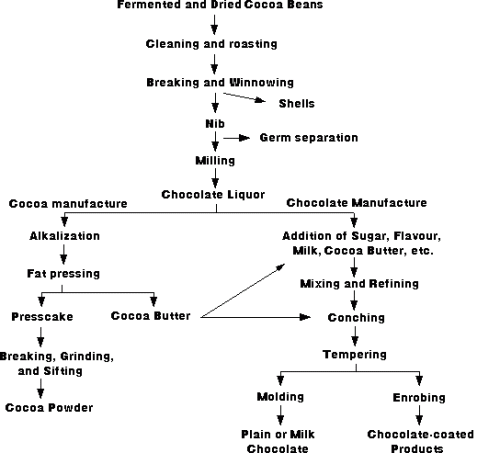Ice Cream Flavours
23 Chocolate and Cocoa
The cacao bean is the fruit of the tree Theobroma cacao, (Cacao, food of the gods) which grows in tropical regions such as Mexico, Central America, South America, West Indies, African West Coast. The word cocoa is a corruption of the native word cacao. The beans are embedded in pods on the tree, 20-30 beans per pod. When ripe, the pods are cut from the trees, and after drying, the beans are removed from the pods and allowed to ferment, 10 days (microbiological and enzymatic fermentation). Beans then are washed, dried, sorted, graded and shipped.
At the processing plant, beans are roasted, seed coat removed – called the nib. The nib is ground, friction melts the fat and the nibs flow from the grinding as a liquid, known as chocolate liquor.
Liquor:
55% fat, 17% carbohydrate, 11% protein, 6% tannins and many other compounds (bitter chocolate – baking).
Cocoa butter:
fat removed from chocolate liquor, narrow melting range 30 to 36° C
Cocoa:
after the cocoa butter is pressed from the chocolate liquor, the remaining press cake is now material for cocoa manufacture
The amount of fat remaining determines the cocoa grade:
- medium fat (Breakfast) cocoa 20-24% fat
- low fat 10-12% fat

Cocoa powder can also be alkalized, which reduces acidity/astringency and darkens the colour. Slightly alkalized cocoa is usually preferred in ice cream because it gives a deeper colour but the choice depends upon:
- consumer preference
- desired color (Blackshire cocoa may be used to darken color)
- strength of flavour
- fat content
There are many types of chocolate that differ in the amounts of chocolate liquor, cocoa butter, sugar, milk, other ingredients, and vanilla.
Imitation chocolate
replacing some or all of the cocoa fat with other vegetable fats. Improved coating properties, resistance to melting
White chocolate
cocoa butter, MSNF, sugar, no cocoa or liquor
In chocolate ice cream manufacture, cocoa is more concentrated for flavouring than chocolate liquor (55% fat) because cocoa butter has relatively low flavour. However, the cocoa fat adds texture to the ice cream. Acceptable mixes can be made using 3% cocoa powder, 2.5% cocoa powder plus 1.5% chocolate liquor, or 5% chocolate liquor.
A good chocolate ice cream will be made if the cocoa and/or chocolate liquor is added to the vat and homogenized with the rest of the mix. Chocolate mixes have a tendency to become excessively viscous sostabilizer content and homogenizing pressure need to be adjusted.
One problem is called chocolate specking. It can occur in soft serve ice cream, when cocoa fibres become entrapped in the churned fat.

